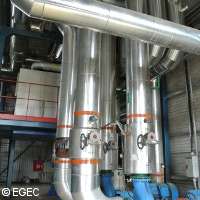Exploiting the potential of geothermal district heating

Recent turbulence in Ukraine has led to an even more intensified hunt for secure sources of energy for Europe. Geothermal district heating (GeoDH) is one of the solutions being touted as a valuable and immediate option for the alleviation of Central and Eastern Europe's dependency on Russian gas.
While over 25 % of the EU population lives in areas directly suitable for GeoDH, the significant potential of deep geothermal is not yet being fully exploited in Europe. The work of GEODH, a project funded under the European Commission's Intelligent Energy Europe (IEE), may help to change this. GEODH has recently presented for the first time the potential of geothermal district heating in Europe on an interactive map.
The map, based on research undertaken by the GEODH team, reveals some interesting findings. For example, we see that GeoDH can be developed in all 28 EU countries and that geothermal can be installed with existing DH systems during extension or renovation, replacing fossil fuels. Additionally, new GeoDH systems can be built in many regions of Europe at competitive costs. The map also shows that the Pannonian basin (Hungary, Romania, Croatia and Serbia) is a place of particular interest when looking at potential development in Central and Eastern Europe.
Geothermal heating and cooling brings many advantages: not only does it provide local, baseload and flexible renewable energy, it also allows for a diversification of the energy mix, and protection against volatile and rising fossil fuels prices.
That's why the GEODH project team is working to achieve increased awareness on the potential applications and benefits of DH&C with geothermal energy. The interactive map is just one aspect of consortium's activities. The team is working to develop a set of recommendations for removing barriers and improving regulatory frameworks. They are also nurturing a better understanding of GeoDH related technologies, costs and financing, and aim to transfer best practices to national and local authorities.
However, the current landscape in Europe is not necessarily straightforward. The challenges to expanding the potential of GeoDH differ from country to country. In Hungary, Poland and Slovakia, the challenge is to remove administrative and financial barriers while in Bulgaria, Czech Republic and Slovenia, there is both the need to convince decision makers and to adopt the right regulatory framework. Germany, France and Italy meanwhile need to simplify procedures and provide more financing in order to achieve the bold GeoDH targets that they have already set out. Finally, the 'juvenile' markets of Netherlands, UK, Ireland and Denmark are currently developing their first geothermal DH systems and there is a need to establish the correct market conditions.
The GEODH consortium is working with these different groups (juvenile, in transition and mature markets) which cover 14 countries covered in total. The team is focusing on proposing the removal of regulatory barriers; developing innovative financial models for GeoDH and training technicians and decision-makers of regional and local authorities in order to provide the technical background necessary to approve and support projects.
Provided by CORDIS



















